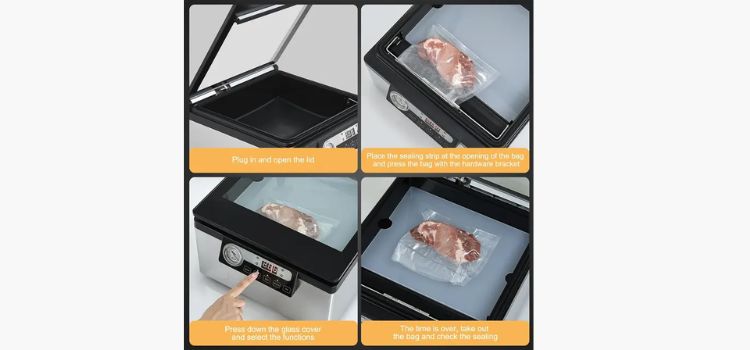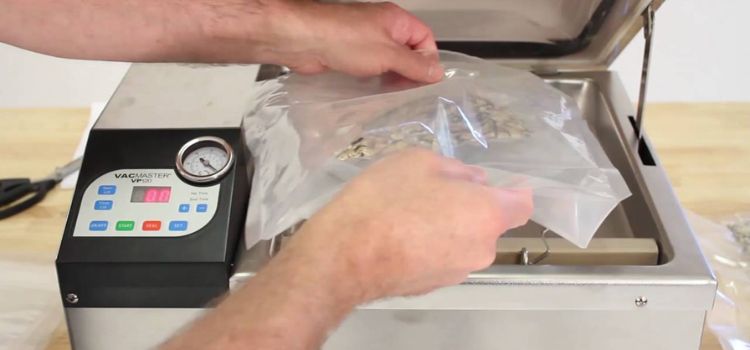As an Amazon Associate, I earn from qualifying purchases

Vacuum sealing has become an essential technique in both home kitchens and professional settings, offering a reliable way to preserve food by removing air from the packaging. This process not only extends the shelf life of food but also helps in maintaining its flavor and nutritional value.
Among the various types of vacuum sealers available, chamber vacuum sealers stand out for their efficiency and versatility. But how exactly do these machines work, and what makes them different from other vacuum sealers?
Understanding Chamber Vacuum Sealers
Chamber vacuum sealers are sophisticated devices designed to create a vacuum environment inside a chamber, allowing for the sealing of bags with precision. Unlike external vacuum sealers, which remove air from the bag by suction, chamber vacuum sealers place the entire bag inside a chamber. This design allows for a more controlled and consistent vacuum process.
The basic components of a chamber vacuum sealer include the chamber itself, a vacuum pump, a sealing bar, and a control panel. The vacuum pump is responsible for removing air from the chamber, while the sealing bar applies heat to seal the bag. The control panel allows users to adjust settings such as vacuum time and sealing time, providing flexibility for different types of food and packaging materials.
How Chamber Vacuum Sealers Work
The operation of a chamber vacuum sealer involves several steps, each crucial to achieving an airtight seal. Here’s a detailed look at the process:
- Placement of the Bag: The food item is placed inside a vacuum bag, which is then positioned within the chamber. The open end of the bag is laid across the sealing bar.
- Chamber Closure: Once the bag is in place, the chamber lid is closed, creating a sealed environment.
- Vacuum Creation: The vacuum pump activates, removing air from the entire chamber, including the bag. This step is key to the chamber vacuum sealer’s ability to handle liquids and moist foods, as the pressure inside and outside the bag remains equal, preventing spillage.
- Sealing: After the air is evacuated, the sealing bar heats up, melting the bag’s open edge to create a secure seal. The heat and pressure ensure that the seal is strong and airtight.
- Air Reintroduction: Once the bag is sealed, air is reintroduced into the chamber, allowing the lid to be opened and the sealed bag to be removed.
This method ensures a consistent vacuum and seal, making chamber vacuum sealers ideal for a wide range of applications, from sous vide cooking to long-term food storage.
Advantages of Chamber Vacuum Sealers

Chamber vacuum sealers offer several advantages over other types of vacuum sealers:
- Sealing Liquids and Moist Foods: One of the standout features of chamber vacuum sealers is their ability to seal liquids and moist foods without the risk of spillage. This makes them perfect for sealing soups, stews, and marinated items.
- Versatility: These machines can accommodate various bag sizes and materials, providing flexibility for different packaging needs. Whether you’re sealing small portions or bulk quantities, a chamber vacuum sealer can handle the task.
- Enhanced Vacuum Strength: Chamber vacuum sealers typically offer stronger and more consistent vacuum pressure compared to external sealers. This results in a more reliable seal and better preservation of food quality.
Disadvantages of Chamber Vacuum Sealers
Despite their benefits, chamber vacuum sealers also have some drawbacks:
- Size and Cost: Chamber vacuum sealers are generally larger and more expensive than their external counterparts. This can be a consideration for those with limited space or budget constraints.
- Complexity: For first-time users, the operation of a chamber vacuum sealer may seem complex. However, with practice and familiarity, the process becomes more intuitive.
- Maintenance and Cleaning: These machines require regular maintenance to ensure optimal performance. Cleaning the chamber and sealing bar is essential to prevent contamination and extend the machine’s lifespan.
Conclusion
Chamber vacuum sealers are powerful tools for food preservation, offering unique advantages in terms of vacuum strength and the ability to seal liquids. While they may require a larger investment and some initial learning, their benefits in preserving food quality and extending shelf life are undeniable.
When choosing a vacuum sealing method, consider your specific needs and the types of food you plan to seal. With the right approach, a chamber vacuum sealer can be a valuable addition to any kitchen, providing reliable and efficient food preservation.
FAQ
How does a vacuum sealer chamber work?
A vacuum sealer chamber works by placing the entire bag inside a sealed chamber. The machine removes air from both the chamber and the bag, creating an equal pressure environment. Once the air is evacuated, the bag is sealed with heat, ensuring a secure, airtight seal.
Is a chamber vacuum sealer better?
A chamber vacuum sealer is often better for specific tasks, such as sealing liquids and achieving stronger vacuum seals. It’s ideal for commercial use due to its efficiency and versatility. However, it tends to be larger and more expensive, making it less suitable for casual, home use.
Can you use regular vacuum bags in a chamber vacuum sealer?
Yes, you can use regular vacuum bags in a chamber vacuum sealer. In fact, chamber sealers are compatible with a wider range of bag types and sizes, including thicker materials and any vacuum-sealable bags, offering greater flexibility compared to external sealers.
As an Amazon Associate, I earn from qualifying purchases